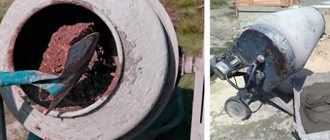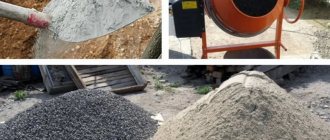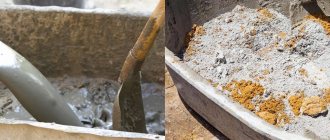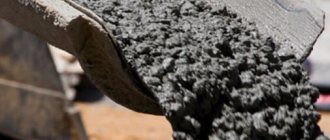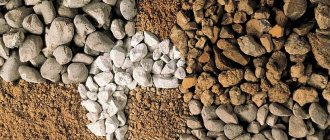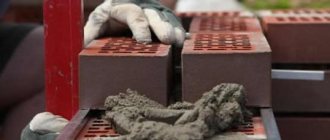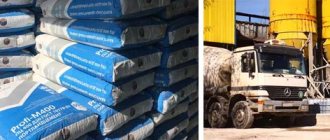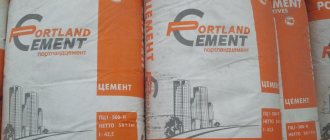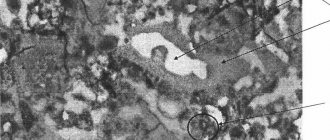Concrete is the most reliable and popular material in the construction industry. If you add the necessary additives to the cement-sand mixture and pour this composition onto the reinforcing frame, you will form a very solid foundation for future construction. However, in order to build a foundation that will not collapse under the influence of loads and the external environment, you need to prepare the solution correctly. If you adhere to the correct proportions and mix all the components well, then the service life of such a base can exceed 50 years.
Concrete composition
Concrete is a mixture of cement (plays the role of a binding component), filler (sand, small particles of gravel or other components), additives (additives that increase frost resistance and other parameters of the finished structure) and water. The composition of such a mixture is periodically improved, and more “recipes” for preparing better mixtures appear.
For example, for strip foundations, some prefer to make rubble concrete. In this case, large rubble stones are used as filler, of which there should be at least 15% in the base. This allows you to save on cement and create a stylish base that actually does not need finishing. Such a foundation is not only stronger, but also much more resistant to low temperatures and the influence of groundwater. Thanks to these characteristics, such a foundation will last up to 150 years.
But this composition is more expensive, so in private construction they usually give preference to more classic mixtures.
Standard composition
Before building a country house, fence, barn, toilet and any outbuildings, you should pay attention to the features of the components:
- Sand. Not everyone is suitable for durable concrete. You need to choose exclusively purified sand (can be river or quarry). If there are impurities in it, then such a foundation will not last long.
- Crushed stone. This component gives the mixture strength. As a rule, gravel with a fraction of 5-20 mm is used.
- Plasticizers. You can do without them. But today there are many additives on sale that increase the service life of the base and simplify the mixing process.
Healthy! Additives that increase the plasticity of the mixture are recommended to be used if you are using a reinforcing frame.
- Water. The main requirement is that it must be clean. If it is drawn from a reservoir, then it is necessary to pass the liquid through a filter.
Of course, any foundation will require cement.
Required grade of cement
The grade of cement and the future concrete itself is indicated by the symbol “M”. The numbers after it determine the mass load threshold. That is, if we mix cement M 200, then after the mass hardens, such a base will be able to withstand up to 200 kg per 1 cm2 of surface. However, when it comes to concrete, Portland cement (PC) is usually used. This is a binder consisting of cement clinker, additives, and gypsum. There are many brands of it (from M 50 to M 600).
If you are planning to build a foundation, then PC 200 or 400 is usually used for such foundations. Portland cement grade 600 is much more expensive and is usually used in the construction of industrial or other specialized facilities. Therefore, PC 200-400 is enough to obtain concrete of the desired grade.
Types of concrete foundations
Several types of concrete foundations are used in construction. Most often, buildings are erected on strip or columnar foundations. Both types, in turn, have several options.
Strip foundation
It is located strictly under the load-bearing walls and is a support belt that repeats the outlines of the elements resting on it. The laying depth is determined depending on the freezing mark of the soil and, as a rule, is 20-30 cm below this level. The following types of strip foundations are distinguished:
- monolithic;
- made;
- rubble;
- rubble-concrete.
To construct a monolithic foundation, concrete reinforced with various types of reinforcing mesh is used. The work of reinforcing and pouring the concrete mixture is carried out directly on the site, with or without the use of formwork (automatic calculation).
The monolith is laid during the construction of a building made of heavy materials, with a ground or basement floor.
The prefabricated foundation structure consists of reinforced concrete blocks. In this case, narrower elements are installed on wide foundation pads, which ensure distribution of the load on the ground. The block base can be continuous or discontinuous. Mounting such a base is less labor-intensive than pouring a monolith, but requires adjusting the blocks to the dimensions specified by the project and is inferior in strength. The prefabricated type is suitable for soils with shallow freezing that are not prone to swelling.
When installing the foundation, rubble is used on soils with high water levels and deep freezing. The work of laying such a foundation is labor-intensive and time-consuming. This is due to the fact that large rubble stones are placed on cement mortar and adjusted in size and shape. The main advantages of such masonry are its durability and strength.
Proportions of concrete in buckets (for foundations, outdoor screeds, fence posts)
The rubble-concrete foundation consists of approximately the same amount of small stone and cement mortar. The characteristics are similar to rubble, but the materials for it are more accessible, and the laying is simpler, because in this case careful adjustment is not required.
Columnar foundation type
Designed for the construction of light structures. Usually, small country houses, sheds, and bathhouses are built on its basis. Support pillars are placed at the corners of the building and in places with the greatest load. Concrete or concrete blocks, as well as rubble and metal pipes are suitable for their formation. It is not advisable to install a columnar base on loose soils saturated with moisture.
For the construction of large objects on unstable, soft or heaving soils, columnar strip foundations are suitable. They combine support pillars that go deep into the soil to reach its hard layers and a concrete strip, which is a connecting element and is located at a shallow depth.
Proper installation of the foundation structure for a building ensures its durability. To fill the base, you can use ready-made mixtures that are supplied to the construction market by industrial enterprises. However, in private construction, it is preferable to make concrete for the foundation yourself, as this significantly saves the budget. Of course, it is impossible to obtain the M500 brand in this way, but this is not required for low-rise buildings.
What brand of concrete is needed for the foundation?
To build a house, concrete M 200-350 is required. In this case, this will be a sufficient indicator. But, additionally, you need to pay attention to the strength class of concrete. It is usually marked with the letter “B”. The higher the grade of concrete, the greater this figure will be. For the simplest construction, B 7.5 is enough. But to determine more accurately, you need to start from the type of future building:
- For the lightest building for household purposes (chicken coop, gazebo, greenhouse, etc.), the grade of the ready-made mixture can be 100-150.
- If we are talking about a bathhouse or a garage building, then you will need to ensure that the strength class of the concrete is not lower than B 10. Therefore, the finished mixture should be grade 150-200.
- There will always be people in the house, furniture, appliances, etc. will be installed. Therefore, the strength of concrete must be at least B 15. Therefore, it is necessary to prepare concrete M 200.
You can determine more accurately if you take into account the characteristics of the soil, region and other subtleties. Therefore, the above data is conditional. Of course, you don’t have to rack your brains and prepare the most durable composition, but such a base will be very expensive.
Calculation of concrete volume
Remembering the proportions of cement for the foundation and other components of the solution, you can produce the required volume of concrete. Before starting work, it is important to decide exactly how much material is needed to fill the entire base at once.
For calculations, elementary geometric formulas will be required. If we are talking about a strip foundation, then each side has the shape of a parallelepiped. Then to calculate the volume of the material, simply multiply the length, height and width of the base.
The calculation rules are presented in more detail in the video.
Correct proportions for preparing concrete
First of all, you need to decide how exactly the solution will be mixed. Manual preparation of the batch is rational only if a small amount of concrete is needed, for example, to repair part of the foundation. In all other situations, it is better to use a concrete mixer. All components are added to it and mixed until smooth.
As a rule, to create a cement-sand mixture, a measure in the form of buckets is used. The standard composition is mixed from 1 part cement, 3 parts sand and 5 parts crushed stone or gravel. It is worth noting that each of these components can weigh differently, depending on the fraction, so it is better to take a little more cement, for example: 2 parts (buckets) of cement, 5 parts (buckets) of sand and 9 parts (buckets) of gravel.
If possible, it is worth purchasing a ready-made sand and gravel mixture (PGM). If you are working with such a composition, then you will need 1 bucket of cement for 5 buckets of ASG.
Healthy! If the construction of the foundation is carried out in the cold season, then all components must be heated to a temperature of 60 degrees. Otherwise, you will not get a homogeneous mass.
To build a small frame house on a reliable and durable basis, you need concrete M 200. To prepare a solution for 1 m3, you need to mix 300-350 kg of PC (grade 400-500), about 1150 kg of washed crushed stone and 600-700 kg of clean sand. All this is filled with 150-180 liters of water.
Components of concrete mixtures
Concrete is a building mixture based on cement binders.
The concrete solution for the foundation must include the following components:
- Cement of various brands.
- Sand.
- Filler, which is most often used crushed stone. Lightweight concrete with other fillers is practically not used for foundations.
- Water.
In some cases, various modifiers are added to the solution that can change some properties. The most common are plasticizers and frost-resistant additives, which allow concrete work to be carried out even in subzero temperatures.
Concrete consistency
Based on their condition, the following types of concrete mixtures can be divided:
- Rigid mortars are capable of withstanding significant loads upon achieving the design strength. The density of such a mixture is at least 1800 kilograms per cubic meter. The consistency of the foundation mortar (hard type) resembles wet soil, it is practically incapable of moving by gravity, after laying in the formwork it is necessary to tamp such concrete, otherwise its performance characteristics will deteriorate significantly.
- Concrete mortar of liquid consistency has a slightly lower load-bearing capacity. Its advantage is that the execution of concrete work is significantly simplified, thanks to the gravity filling of formwork structures. This not only speeds up the process, but also reduces the cost of completing the work.
For foundation structures of the highest quality that can withstand significant loads, rigid concrete mixtures must be used. In this case, the technology for producing concrete mortar and the methods of its laying and compaction must be strictly observed.
Main brands of concrete mixtures
The properties of concrete depend on its composition; the following grades of concrete are most often used in construction:
- M 50, this brand of foundation mortar is the cheapest, but it cannot be used for constructing structures that will work with high loads. The composition of this mixture is as follows: 1 part cement (grade 400), 4 parts sand and 6 parts crushed stone. Depending on the brand of cement binder used, the ratio of components may vary slightly.
- The most commonly used concrete is grade M 100, which has the following composition 1-3-5 (cement, sand, crushed stone). This mixture has excellent strength and can withstand significant loads.
The composition of the concrete mortar for the foundation also includes a certain amount of water. Depending on the required consistency, from 0.05 to 0.7 liters per kilogram of cement is used . At the same time, you should not make the solution too liquid, as this will affect its strength.
For the production of concrete mixtures, crushed stone with a fraction of 20-40 mm is most often used; in this case, the most plastic solution can be obtained.
How to mix concrete
As already mentioned, these manipulations can be performed manually. To do this you will need to prepare a container. For example, an old bathtub, trough or any other product will do. You also need a bayonet shovel and a rake.
The preparation of the mixture will look like this:
- Pour the required amount of cement and sand into the prepared container.
- Mix all ingredients intensively with a shovel until smooth. This will take time and effort.
- Pour in clean water and mix everything again.
- Add crushed stone and mix everything again.
Some people, on the contrary, first mix sand and crushed stone. After this, furrows are made in the dry mixture, which are filled with cement. All components are thoroughly mixed. After this, the composition is shaped into a cone and water is slowly poured in. After another mixing, the concrete is ready.
Important! If you still prepare the solution by hand, then it should be used as quickly as possible. Even if all the components are very well mixed, the solution will begin to separate much faster. If you pour it in this form as a foundation for a house, it will not have all the necessary characteristics.
For mechanical mixing you will need a concrete mixer. You can buy it, rent it, or even make it yourself. In this case, preparing the solution is greatly simplified:
- Pour the required amount of cement into the mixer.
- Wet it with water and mix. This is repeated several times until a mass resembling an emulsion is obtained.
- Add sand and wait again until everything is mixed until smooth.
- At the final step, add gravel and other fillers and additives.
As you can see, even the technique of mixing the components can be different. Therefore, it cannot be said for sure that there is one single option for the proportions of the concrete mixture. It all depends on the specific conditions and even on the type of fundamental basis.
Features of preparing concrete for the foundation
Today, tape-type bases are most in demand. In this case, in order to more accurately determine how much concrete will be needed, you need to determine the length, width and height of one strip and multiply the resulting figure by the number of such “strips” in the foundation. Suppose we get a length of 30 meters, a width of 0.7, and a depth of 0.5 m. In this case, multiplying all these numbers, we get 10.5 m3 of ready-made solution per tape. If there are 4 of them, then you need to prepare mixtures for 42 m3. It is worth considering that this type of foundation is poured into the formwork in layers. This means that in this case the manual method of mixing the components will not work.
But for a columnar base, the calculations look the same, but the filling is done at one time. Therefore, theoretically, you can prepare the batch yourself using a shovel and a bath.
When determining the proportions of concrete, it is worth paying attention to the thickness of the fundamental foundation of the house. For example, a thicker consistency will be needed if the thickness of the structure is 10-40 cm.

